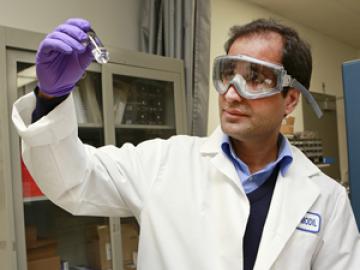Filter News
Area of Research
- (-) Chemistry and Physics at Interfaces (5)
- (-) Energy Sciences (3)
- (-) Fusion Energy (2)
- Advanced Manufacturing (15)
- Biological Systems (15)
- Biology and Environment (86)
- Biology and Soft Matter (1)
- Building Technologies (4)
- Clean Energy (268)
- Climate and Environmental Systems (3)
- Computational Biology (4)
- Computational Engineering (2)
- Computer Science (7)
- Data (1)
- Electricity and Smart Grid (1)
- Energy Frontier Research Centers (8)
- Fossil Energy (2)
- Fuel Cycle Science and Technology (1)
- Functional Materials for Energy (9)
- Fusion and Fission (26)
- Geographic Information Science and Technology (2)
- Isotope Development and Production (2)
- Isotopes (19)
- Materials (260)
- Materials Characterization (2)
- Materials for Computing (13)
- Materials Synthesis from Atoms to Systems (6)
- Materials Under Extremes (6)
- National Security (41)
- Neutron Science (90)
- Nuclear Science and Technology (32)
- Nuclear Systems Modeling, Simulation and Validation (1)
- Nuclear Systems Technology (1)
- Quantum Condensed Matter (1)
- Quantum information Science (2)
- Reactor Technology (1)
- Renewable Energy (1)
- Sensors and Controls (2)
- Supercomputing (125)
- Transportation Systems (5)
News Type
News Topics
Media Contacts

Kathy McCarthy has been named director of the US ITER Project Office at the Department of Energy’s Oak Ridge National Laboratory, effective March 2020.

The U.S. Department of Energy announced funding for 12 projects with private industry to enable collaboration with DOE national laboratories on overcoming challenges in fusion energy development.


From the bluebird painting propped against her office wall and the deer she mentions seeing outside her office window, Linda Lewis might be mistaken for a wildlife biologist at first glance. But rather than trailing animal tracks, Lewis, a researcher at the Department of Energy’s Oak Ridge National Laboratory, is more interested in marks left behind by humans.

Less than 1 percent of Earth’s water is drinkable. Removing salt and other minerals from our biggest available source of water—seawater—may help satisfy a growing global population thirsty for fresh water for drinking, farming, transportation, heating, cooling and industry. But desalination is an energy-intensive process, which concerns those wanting to expand its application.

Graphene, a strong, lightweight carbon honeycombed structure that’s only one atom thick, holds great promise for energy research and development. Recently scientists with the Fluid Interface Reactions, Structures, and Transport (FIRST) Energy Frontier Research Center (EFRC), led by the US Department of Energy’s Oak Ridge National Laboratory, revealed graphene can serve as a proton-selective permeable membrane, providing a new basis for streamlined and more efficient energy technologies such as improved fuel cells.

Treating cadmium-telluride (CdTe) solar cell materials with cadmium-chloride improves their efficiency, but researchers have not fully understood why.







